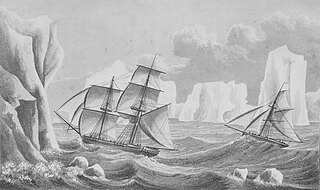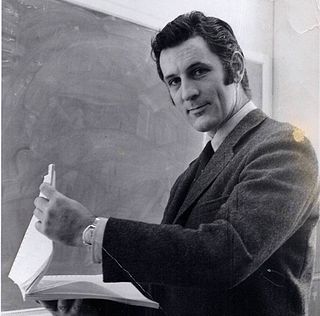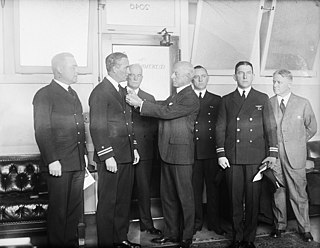Related Research Articles

The history of Antarctica emerges from early Western theories of a vast continent, known as Terra Australis, believed to exist in the far south of the globe. The term Antarctic, referring to the opposite of the Arctic Circle, was coined by Marinus of Tyre in the 2nd century AD.

Richard Evelyn Byrd Jr., an American naval officer, was a pioneering American aviator, polar explorer, and organizer of polar logistics. Aircraft flights in which he served as a navigator and expedition leader crossed the Atlantic Ocean, a segment of the Arctic Ocean, and a segment of the Antarctic Plateau. He is also known for discovering Mount Sidley, the largest dormant volcano in Antarctica.

Lincoln Ellsworth was a polar explorer from the United States and a major benefactor of the American Museum of Natural History.

Paul Allman Siple was a North American Antarctic explorer and geographer who took part in six Antarctic expeditions, including the two Byrd expeditions of 1928–1930 and 1933–1935, representing the Boy Scouts of America as an Eagle Scout. In addition to being an Eagle Scout, Siple was also a Sea Scout. His first and third books covered these adventures. With Charles F. Passel he developed the wind chill factor, and Siple coined the term.

Marie Byrd Land (MBL) is an unclaimed region of Antarctica. With an area of 1,610,000 km2 (620,000 sq mi), it is the largest unclaimed territory on Earth. It was named after the wife of American naval officer Richard E. Byrd, who explored the region in the early 20th century.

Bear Peninsula is a peninsula about 80 km (50 mi) long and 40 km (25 mi) wide which is ice-covered except for several isolated rock bluffs and outcrops along its margins, lying 48 km 30 mi) east of Martin Peninsula on Walgreen Coast, Marie Byrd Land, Antarctica.

Brown Station is an Argentine Antarctic base and scientific research station named after Admiral William Brown, the father of the Argentine Navy. It is located on Sanavirón Peninsula along Paradise Harbor, Danco Coast, in Graham Land, Antarctic Peninsula.

The Byrd Station is a former research station established by the United States during the International Geophysical Year by U.S. Navy Seabees during Operation Deep Freeze II in West Antarctica.
Prince Andrew Plateau is an ice-covered plateau, about 40 nautical miles long and 15 nautical miles wide, lying south of Mount Rabot in the Queen Elizabeth Range of Antarctica.

Terence James Elkins is an Australian-born American physicist. In 1960, he participated in an expedition from Mawson Station which conducted the first geological surveys of the Napier Mountains in Enderby Land, East Antarctica. The highest of this group of mountains, Mount Elkins, was subsequently named after him. In 1979, he received the Harold Brown Award, the United States Air Force's highest honor for research and development, for research he conducted that contributed to the development of the AN/FPS-115, AN/FPS-117 and AN/FPS-118 over-the-horizon backscatter (OTH-B) air defense radar system. Designed to replace the aging Ballistic Missile Early Warning System system, these systems are among the most powerful early-warning radar systems ever developed.
Mount Bursey is a broad, ice-covered mountain, 2,780 metres (9,120 ft) high, which forms the eastern end of the Flood Range in Marie Byrd Land, Antarctica.
Holcomb Glacier is a glacier which drains northward to the coast of Marie Byrd Land, Antarctica, 9 nautical miles (17 km) southeast of Groves Island. It was mapped by the United States Geological Survey from surveys and U.S. Navy aerial photographs, 1959–65, and was named by the Advisory Committee on Antarctic Names for Leroy G. Holcomb, an ionospheric physicist who worked at Byrd Station in 1971.
Mount Rossman is a prominent wedge-shaped, ice-free mountain, 1,450 m, located at the north end of the Enterprise Hills between Union and Henderson Glaciers, in the Heritage Range in Antarctica. It was mapped by the United States Geological Survey (USGS) from surveys and U.S. Navy air photos from 1961 to 1966. It was named by the Advisory Committee on Antarctic Names (US-ACAN) after Rossman W. Smith, Jr., an ionospheric physicist at Eights Station, Antarctica in 1965, the Station Scientific Leader at Byrd Station, Antarctica in 1967, and a glaciologist on the Queen Maud Land Traverse, Antarctica in 1968, when it was still "Terra Incognita".

Harold Irving June (1895–1962) was a machinist, an aviator, a test pilot, and an explorer in Antarctica. He is best known for his 1928–1930 service in the first Antarctic expedition of Admiral Richard E. Byrd. Sitting in the co-pilot's seat with supplemental radio duties, he flew with Byrd, pilot Bernt Balchen, and photographer Ashley McKinley over the South Pole on November 29, 1929.
Sobral Scientific Base was a permanent, all year-round and now only partially active Argentine Antarctic base and scientific research station named after Argentine polar explorer and scientist José María Sobral. It is located on the Filchner Ice Shelf.

On 9 December 2019, a Chilean Air Force Lockheed C-130 Hercules military transport aircraft crashed in the Drake Passage while en route to Base Presidente Eduardo Frei Montalva, a Chilean military base on King George Island in Antarctica.
Blake Peak is an isolated peak on the southwest side of Siemiatkowski Glacier in Marie Byrd Land. Mapped from surveys by the United States Geological Survey (USGS) and U.S. Navy air photos (1959-65). Named by Advisory Committee on Antarctic Names (US-ACAN) for Dale G. Blake, ionospheric scientist at Byrd Station, 1964.

International competition extended to the continent of Antarctica during the World War II era, though the region saw no combat. During the prelude to war, Nazi Germany organised the 1938 Third German Antarctic Expedition to preempt Norway's claim to Queen Maud Land. The expedition served as the basis for a new German claim, called New Swabia. A year later, the United States Antarctic Service Expedition established two bases, which operated for two years before being abandoned. Responding to these encroachments, and taking advantage of Europe's wartime turmoil, the nearby nations of Chile and Argentina made their own claims. In 1940 Chile proclaimed the Chilean Antarctic Territory in areas already claimed by Britain, while Argentina proclaimed Argentine Antarctica in 1943 in an overlapping area.

Little Rockford was an Antarctic exploration base from December 1958 to January 1965, located on the Ross Ice Shelf, south of the Bay of Whales. Little Rockford was a field camp and weather station along the Little America tractor trail and was located between McMurdo Sound and Byrd Station, 160 miles from Little America. It was named after Rockford, Illinois, the hometown of Admiral George Dufek. Admiral Dufek was in charge of the United States military mission, through the United States Navy, to support research in Antarctica named Operation Deep Freeze, and the first man to land at the South Pole by airplane.
Eights Station was an Antarctic permanent exploration base from January 1963 to November 1965, located on Ellsworth Land about 1100 km from Byrd Station and 2400 km from McMurdo Station. The station consisted of 11 prefabricated buildings that were brought in via planes and located on the site of the former "Sky-Hi" airlift project temporary scientific camp. The station was named for James Eights who was the first American Naturalist who visited Antarctica at the beginning of the 19th Century. The station was initially supported by 6 scientists and 5 Armed Forces attendants and included observations on meteorology, the ionosphere, geomagnetism, and aurora and radio waves. At its peak, Eights Station hosted 27 personnel, including individuals from the U.S. Antarctic Research Program Summer Party.
References
- 1 2 3 Bulletin of the United States Antarctic Projects Office. Vol. 6. U.S. Antarctic Projects Office. 1965. p. 2. Retrieved 13 December 2020.
- 1 2 Antarctic Report (PDF). National Science Foundation. May 1965. p. 13. Retrieved 13 December 2020.
- ↑ "Antarctic Scientist Wanders, Dies". San Bernardino Sun. No. 71. 10 May 1965. Retrieved 13 December 2020.
- ↑ Childress, David (May 20, 2020). Antarctica and the Secret Space Program: From WWII to the Current Space Race. SCB Distributors. ISBN 978-1-948803-28-1 . Retrieved 13 December 2020.
- ↑ "Disch Promontory". Geographic Names Information System . United States Geological Survey, United States Department of the Interior . Retrieved 2012-01-21.